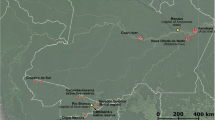Abstract
Thirteen species of fleshy fungi were identified from two agricultural fields during the 1989 and 1990 growing seasons at the Rural Development Center (RDC) and Horticulture Farm, Coastal Plain Experiment Station, Tifton, Georgia. The three most common fungi wereCoprinus plicatilis, Cyathus olla, andPanaeolina foenisecii. At the former site, residue management practices were established for evaluating crop production and at the Horticulture Farm different crops were grown with conservation tillage employing a Low Input Sustainable Vegetable Production system. Tillage treatments at the RDC were no-till, row-till, ridge-plant, and moldboard-plowing. Residue management of triticale included burning or cutting the stubble at a height of 20 or 60 cm at harvest. At the Horticulture Farm, seven winter cover crops were compared to a fallow control. No significant differences were shown between observations of fungal species and individual treatments at the Horticulture Farm during 1989 and 1990. However, there were treatment differences for observed fungi at the RDC farm on specific dates for both years. Furthermore, no individual treatment(s) during the investigation increased observation rates of specific fungal species. Non-burned debris treatments showed consistently higher populations and diversity of fungi than burn debris plots.
Similar content being viewed by others
References
Hiemstra HD, Bauder JW. Conservation tillage: Strategies for the future. Proc Conf Conserv Tillage, Conservation Tillage Information Center, Fort Wayne, IN, 1984: 100 pp.
Gudmestad NC, Huguelet JE, Zink RT. The effect of cultural practices and straw incorporation into the soil onRhizoctonia disease of potato. Pl Dis Rep 1978; 62: 985–89.
Sumner DR, Threadgill ED, Smittle DA, Phatak SC, Johnson AW. Conservation tillage and vegetable diseases. Pl Dis Rep 1986; 708: 906–11.
Chesters CGC. Concerning fungi inhabiting soil. Trans Br Mycol Soc 1949; 32: 197–216.
Warcup JH. Studies of basidiomycetes in soil. Trans Br Mycol Soc 1959; 42: 45–50.
Wacha AG, Tiffany LH. Soil fungi isolated from fields under different tillage and weed-control regimes. Mycologia 1979; 71: 1215–26.
Warcup JH. Studies on the occurrence and activity of fungi in a wheat-field soil. Trans Br Mycol Soc 1957; 40: 237–62.
Bugg RL, Wackers FL, Brunsen KE, Dutcher SD, Phatak SC. Cool-season cover crops relay inter-cropped with cantaloupe: Influence on a generalist predator,Geocoris punctipes (Hemiptera:Lygaeidae). J Econ Entomol 1991; 84(2): 408–16.
SAS Institute Inc. SAS User's Guide: Statistics, 5th ed. Cary, NC: SAS Institute Inc, 1985.
Author information
Authors and Affiliations
Rights and permissions
About this article
Cite this article
Baird, R.E., Summer, D.R., Mullinix, B.G. et al. Occurrence of fleshy fungi from agricultural fields. Mycopathologia 122, 29–34 (1993). https://doi.org/10.1007/BF01103706
Received:
Accepted:
Issue Date:
DOI: https://doi.org/10.1007/BF01103706




